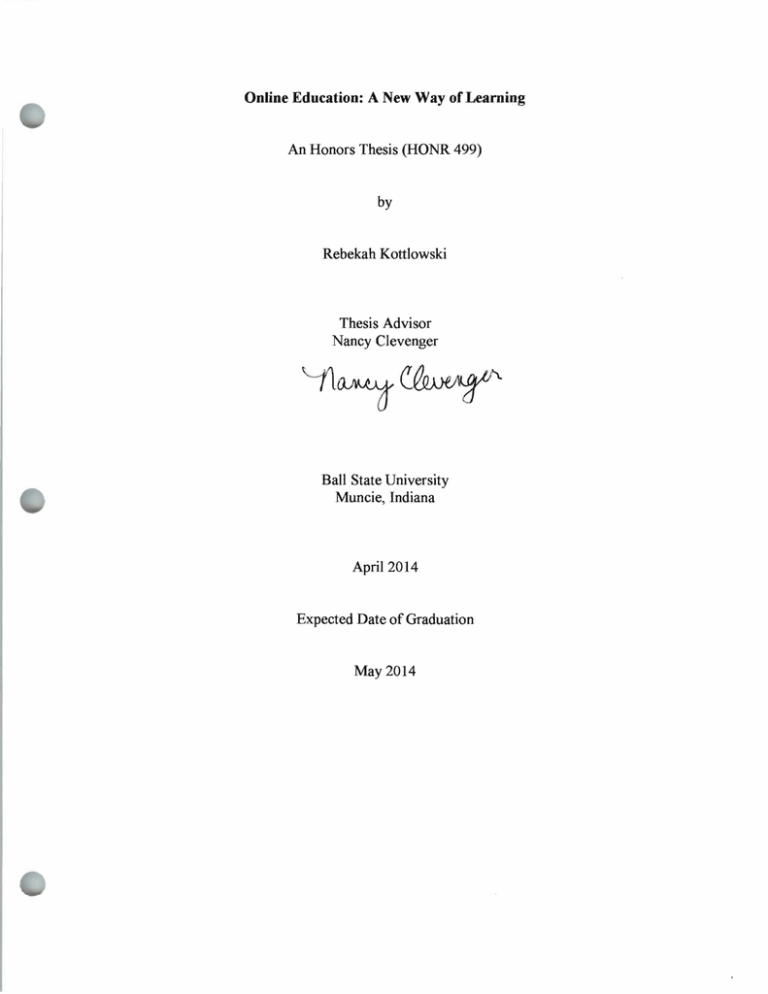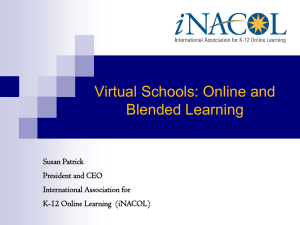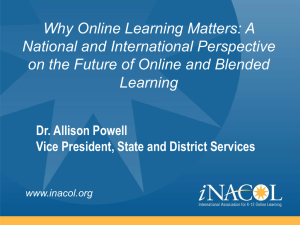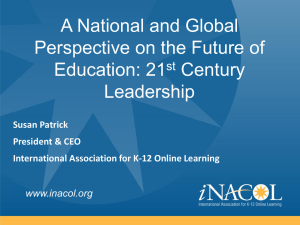Document 11007477
advertisement

Online Education: A New Way of Learning
An Honors Thesis (HONR 499)
by Rebekah Kottlowski Thesis Advisor Nancy Clevenger Ball State University Muncie, Indiana April 2014 Expected Date of Graduation May 2014 .{;;pCoJi
Underqrad
-rhe5~5
L;).~~9
Abstract:
,zL}
;J. 0 ) '-)
·KG8
The purpose of this project is to explore the new and controversial realm of online
education. The varying types of online education, the five-point continuum, online education
organizations, advantages and disadvantages of online education, trends, issues, and information
of current virtual schools are discussed.
Acknowledgments: I would like to thank Mrs. Clevenger for advising me through this project. Her insights dUling this process and during classes in previous semesters have been invaluable. I would like to thank Zechariah, Steve, and Miriam for encouraging me during this process. Kottlowski 2
Introduction:
Bill Gates stated, "Technology is just a tool. In tenns of getting the kids working together
and motivating them, the teacher is the most important." As an elementary education major, I
have learned that integrating technology into the classroom curriculum is becoming integral to
students' success in learning 21 st century skills. In fact, integrating technology has become so
important that many virtual and internet schools have become popular in the last decade. The
widespread growth of technology becoming the teacher has many educators concerned about the
quality of education thousands of students are now receiving. Perhaps in this scenario, the
teacher will become the tool instead of the most important apparatus to learning. Therefore, I
decided to investigate the realm of online learning. Online education takes various forms, has
many advantages and detriments, but has an overall impact on traditional education currently and
will in the future.
Types of Online Learning:
It is essential to understand the differences between the major types of online learning in
order to grasp the scope of online education. There are six major types of online learning, the
first being distance education. "Distance education is teaching and planned learning in which
teaching nonnally occurs in a different place from learning, requiring communication through
technologies as well as special institutional organization" (Moore & Kearsley 15). For example,
a teacher will record a lesson that is later distributed to the students via the Internet. The students
will then listen to the lesson at a later time. Distance education has both learners and a teacher,
content organized around a set of learning objectives, some designed learning experiences, and
some fonn of evaluation. E-Iearning, the second type of online learning, is education that uses
the Internet. This is similar to distance education in that the teacher and learner are not in the
same physical location. However, it is only using the Internet to relay information, versus
distance education that can use paper and other non-Internet materials transferred between the
teacher and student. It can occur in or out of the classroom therefore it can be self-paced,
asynchronous learning or it may be instructor-led synchronous learning. This type of learning is
suited to distance learning and flexible learning, but it can also be used in conjunction with face­
to-face teaching, in which case the tenn blended learning is commonly used. Next is
asynchronous learning: a student-centered teaching method that uses online learning resources to
Kottlowski 3
facilitate information sharing outside the constraints of time and place among a network of
people. It emphasizes the importance of peer-to-peer interaction and utilizes email, electronic
mailing lists, threaded conferencing systems, online discussion boards, wikis, and blogs. This is
different from the traditional classroom in that the student is learning from the teacher at a
different time. For example, the teacher gives access to the student to a website that contains all
the information, assignments, and activities the student will need for the course. The student can
then learn at their own pace to complete the course on a time-table that works best for him or her.
Distributed learning is an instructional model that involves using various information
technologies to help students learn at any place and any time. This is also known as computer­
mediated instruction which encompasses technologies such as video or audio conferencing,
satellite broadcasting and Web-based nlultimedia formats. The last distinction that must be made
is between virtual schools and virtual learning. According to Susan Lowes from the Teachers
College at Columbia University, the term virtual school is used to refer to two very different
types of experiences.
"Fully developed virtual schools offer students the opportunity to take an entire
diploma online while not attending any site-based school. There are relatively few
full-fledged virtual schools as most are charter schools and a few are virtual
schools for students whose schedules make it difficult for them to attend site
based schools, for instance, athletes and actors. Virtual learning, on the other
hand, is what students experience when they take one or more courses online
while also attending their site-based schools."
With these distinctions in mind, one can more clearly distinguish the levels of distance
education.
Online Education Continuum:
There are five central points on the online education continuum. At the far left are single­
mode institutions. At these institutions, distance education is the sole activity. The course
development, instruction, evaluation and other educational processes are tailored to the distance
learner. However, this has not found much favor in the United States in the public sector. Many
learners desire face-to-face and hands-on interaction between the teacher and the student. The
Kottlowski 4
public also tends to assume that the courses, especially at the collegiate level, are not as valid as
those taken at a traditional school or university. Still, the popularity of the University of Phoenix
and K-12 schools such as Connections Academy, Indiana Online Academy and K-12 Inc. may
soon change that opinion. Next are dual-mode institutions. This is an institution that adds
distance education to its previously established campus and class-based teaching. The United
States Army War College and Pennsylvania State University World Campus are prime examples
of this level of distance education. Pennsylvania State University is an established, physical
university in the state of Pennsylvania. In 1998, the University added its World Campus in
addition to the traditional in-person courses already available. Now, students across the United
States, Canada and other countries are able to take courses online that fit his or her schedule. The
United States Army War College is similar in that they added an online component to their
already established school so that students from allover the world can be a part of the school as
well.In the middle of the continuum are individual teachers. Many institutions encourage their
faculty to deliver part of their classroom teaching online or deliver one or more of their courses
as distance education courses with no classroom component. Ball State University encourages
the faculty to initiate such courses. Virtual universities and consortia are organizations that
provide a face in the form of an online portal where members of the consortium list their course
offerings. For example, the Indiana Virtual Learning Consortium is an online portal that
represents The Indiana Academy for Science, Mathematics, and Humanities; Indiana Online
Academy; Indiana University High School; the Indiana Virtual Academy and Ivy Tech. This
consortia brings together a variety of options for students to learn in ways different than the
traditional model. Lastly, individual learning is using the Internet's resources to learn something
on one's own. This comes about through using online encyclopedias, video tutorials and search
engines to teach oneself a new skill or fact. This level is quite unorganized yet very common
form of online learning.
Kottlowski 5
Online Education Organizations:
As the various forms and types of online learning are expanding, there has been a call in
recent years for a governing body or bodies to ensure quality online education. The two main
organizations are ISTE (The International Society for Technology in Education) and iNACOL
(The International Association for K-12 Online Learning). The ISTE website states: "ISTE is the
premier membership association for educators and education leaders engaged in advancing
learning and teaching through innovative and effective uses of technology in PK-12 and teacher
education. Founded in 1979, ISTE has become the trusted source for professional development,
knowledge generation, advocacy, and leadership for innovation." This organization has also
created its own standards for learning, teaching and leading in the digital age and they are widely
recognized and adopted worldwide. Another online education organization is iNACOL
(International Association for K-12 Online Learning). This non-profit organization's focus is to
develop policy for student-centered education and to develop standards for emerging learning
models, such as online learning. According to iNACOL, their goal is to "ensure that students
everywhere have access to a world-class education that prepares them for a lifetime of success,
no matter their geographic location or economic situation."
Advantages of Online Learning:
There are many advantages of online learning for both traditional and exceptional
students. According to the National Primer on K-12 Online Learning some current benefits of
online learning include:
Kottlowski 6
• "expanding the range of courses available to students, especially in small,
rural or inner-city schools, beyond what a single school can offer;
• providing highly qualified teachers in subjects where qualified teachers
are unavailable;
• providing flexibility to students facing scheduling conflicts;
• affording opportunities for at-risk students, elite athletes and performers,
dropouts, migrant youth, pregnant or incarcerated students, and students
who are homebound due to illness or injury;
• providing credit recovery programs for students that have failed courses
and/or dropped out of school, allowing them to get back on track to
graduate;
• helping students that are currently performing below grade-level to begin
catching-up through blended learning;
• addressing the needs of the Millennial student (students who enter college
after the year 2000 who have been immersed in online technology
throughout his or her grade school years);
• providing on-demand online tutoring; increasing the teaching of
technology skills by embedding technology literacy in academic content;
• providing professional development opportunities for teachers, including
mentoring and learning communities" (Wicks 10).
Other advantages include:
• Increasing access to learning and training as a matter of equity
• Improving the cost effectiveness of educational resources, for example in 2005 the Ohio
legislature studied the cost of its eCommunity Schools and found that they spend $5,382
per student compared to $7, 452 for students in brick and mortar charter schools, and $48,
437 for students in traditional, non-charter schools. In 2008, Cathy Cavanaugh conducted
a survey that showed an average yearly cost for a full-time online student at $4,310
compared to the national average of $9,683 per pupil. In 2010, the Alliance for Excellent
Education reported that "the state virtual system in Wisconsin per pupil cost is $6,500 in
the virtual system compared with the national average of almost $10,000 per pupil in a
traditional system." (Wicks 15)
Kottlowski 7
• Improving the quality of existing educational structures through the utilization of technology and other world views. • Enhancing the capacity of the educational system by allowing for another group of
students besides those in the traditional school building to learn at a school.
• Balancing inequalities between age groups so that older students can feel confident in
going back to school
• Delivering educational campaigns to specific target audiences
• Providing emergency training for key target groups such as disaster training for first
responders immediately after an incident
• Expanding the capacity for education in new subject areas
• Adding an international dimension to the educational experience
• Providing alternate ways to accomplish academic tasks, for example "a student with
cerebral palsy may have trouble speaking intelligibly but can engage in a class
'discussion' through online chat or instant messaging. A student in hospital isolation can
use videoconferencing to practice French with a classmate" (Keeler 126).
• Online environments can also reduce the visibility of students' exceptionalities, for
example "Michael Pugliese, a 10-year-old gifted student who took high school courses
online through Oregon's CyberSchool said 'I used to go to school, and the kids were
always making fun of me .... But when I'm talking to older kids on the Internet, it doesn't
matter how old or big I am. In CyberSchool, I'm just the same as the older kids'" (Keeler
126).
Disadvantages of Online Learning:
While there are many advantages to online learning, there is still a strong argument
against online learning. The three main causes of dissatisfaction and resistance to online learning
are: (1) bad course design and teacher incompetence (for example, a hard to navigate website or
a course that provides little to no interaction between the students and teacher) ; (2) Wrong
expectations on part of the students (the students expect the course to be easier, but is not always
the case); (3) poor technology or inability to use technology properly. This being stated, many
students say that they prefer traditional classroom learning even though they enjoyed his or her
distance-learning course and found it worthwhile. Another disadvantage is the misconception of
Kottlowski 8
students in that they may believe that distance education courses are easier than the conventional
classes and require less work; however, this is not the case. Students may also assume that the
distance education courses will be of lesser quality and avoid the courses. Software and hardware
are necessary to engage in online education and this can be costly to some students. The digital
divide ("the disparity in the availability of computers and Internet access among students"
(Wicks 36» may also be an obstacle for many students who would benefit from online learning.
The need for teachers is also a large argument. If online education becomes the norm, fewer
teachers will be needed to guide a class and therefore the demand for teachers may go down
dramatically. Sherri Wood, the president of the Idaho Education Association, stated that online
education "trades teachers for technology." Critics also argue that online learning will be used as
a way for school districts to cut comers on spending-to the detriment of their students'
educations. There is also a concern that the private sector may be behind the push toward online
learning, so that companies creating online content can reap the rewards from taxpayers. The
makeup of courses may be too easy, therefore being used as a means to artificially increase
graduation rates without students gaining the knowledge they need. Online learning is thought to
increase plagiarism as students are completing courses entirely online with no teacher present to
detect plagiarism as well as cheating. Online learning fails to take students' individual learning
styles into account. Online learning adds more screen time for an already tech-saturated
generation. Lastly, future technology changes can hinder software creators from creating a
sound educational product. Online learning may appear in one form now that will morph and
change with the future technology.
Trends in Online Education:
There are five major trends in online education within the past five years according to an
iNACOL survey of Policy and Practice ofK-12 Schools Around the World. These trends are
related to demographics, support from governments and schools, teacher training, the use of
blended learning, and the use of online learning. Trend one: Blended and online choices are most
available to students in urban areas from developed countries. While online learning is used in
many different countries (including but not limited to the U.K., China, Japan, Korea, Brazil,
Finland, Norway, Australia, New Zealand, Republic of South Africa, Turkey, Pakistan, India,
Thailand, Germany, Netherlands, Portugal, Spain, Arab States, France, and Italy) students living
Kottlowski 9
in North America, Western Europe, Asia and Oceania have the most access to these choices.
Trend two: Growth in digital learning stems from shared authority between local schools and
national governments. In the study, almost 60% of the countries reported government funding
for blended or online programs. Trend three: Specialized teacher training is not required but is
encouraged and available. Of the countries that reported government funding for online or
blended learning, 11 % indicated that a specific license or credential was required of a teacher
before teaching in an online or blended classroom and 25% required specific training. Trend
four: Blended learning is occurring with much greater frequency than online learning. Thirty-five
of the 54 countries who responded to the survey indicated that online and blended learning
opportunities were available to at least some students. Exclusively online education is not the
goal but using blended learning as a complement to traditional learning seems to be taking off in
greater numbers. Trend five: The use of online learning is most prevalent by students with
special circumstances. Countries like Belgium, Italy, the Czech Republic, Russia, and Slovenia
reported that "online learning was used most commonly for student athletes, students with
chronic illness and disease, and those who were hospitalized, homebound, incarcerated, and
severely disabled." (Barbour 9-14) Few countries have a widespread general student population
interest in online learning except for New Zealand, Australia, Turkey, China, and British
Columbia.
The countries involved in this survey also listed several issues with online learning
currently. One issue is that there is no clearly defined international understanding of online
learning. There is also a lack of equitable access to the Internet, technology tools, and resources
for online learning. Another issue is a lack of government funding or policies to promote online
learning versus traditional brick-and-mortar schools. Most of the funding is to help integrate
technology into the traditional classroom, not specifically for online learning. There is also a
need to focus on teacher training and their role. Currently, most countries do not require teachers
to have any particular training in the area of online pedagogy. Lastly, the kinds of students being
serviced by online learning is often limited to students with extenuating circumstances, such as
"students who are geographically isolated, are traveling overseas, have medical issues, or who
have selected home education and have access to virtual education." (Barbour 15-17)
Kottlowski 10
Exanlples of Virtual Schools:
The Florida Virtual School in the United States is a completely online school that enrolls
30,000 to 40,000 middle and high school students each year. They offer over 120 courses and are
said to be "as real as the dedicated, certified teachers who teach them." (www.flvs.net) Students
are not required to live in Florida and can be from a public, private or homeschool background
and in grades Kindergarten to 12. However, if a student is a Florida resident, he or she can take
any course for free. According to the Florida Virtual School website, the mission of the school is
to "deliver a high quality, technology-based education that provides the skills and knowledge
students need for success." The school's vision is along the same lines "To transform education
worldwide-one student at a time." The school also has a core set of beliefs including "every
student is unique, so learning should be dynamic, flexible and engaging; students should be
integrated rather than isolated; and students should have choices in how they learn and how they
present what they know."
The K 12 Inc. community of schools is nationwide. This network offers online public
schools, online private schools, and individual courses for sale. The target audience includes:
"everyone from struggling students to advanced learners, college and career-minded students,
families that choose homeschooling, children of families in the military or those with overseas
commitments, elite athletes and performers training for competitions or careers and children who
are homebound for a variety of reasons." (www.kI2.com) The Hoosier Academies in Indiana is
one of the K 12 public schools. It is a public charter school authorized by Ball State University
(Office of Charter Schools) that offers a blend of online learning and face-to-face instruction.
The school is tuition free and offers all Indiana diploma tracks along with support from Indiana­
certified teachers. Core courses include Language Arts, Math, Science, History, Art, and
Physical Education and Wellness.
Conclusion:
The considerably new concept of online education is very far reaching into the realm of
traditional education. The overall impact on education from online education is significant. "K­
12 online learning has the potential to dramatically change the educational experience of every
student in any country, providing access to a world-class education with the best teachers and the
best resources internationally" (Barbour 9). While many educators may not agree with the
Kottlowski 11
specifics of online education, who would not want to help change the educational experience of
every student for the better? Matthew Wicks states in the National Primer that "the research
conducted so far has generally concluded that online learning is as effective as traditional
classroom learning" (Wicks 38). The research and benefits from online education, even in its
simplest form can improve the educational experience of most students. I agree with Bill Gates,
the teacher is the most important in the education equation; but technology is an increasingly
important tool that should not go to waste.
Kottlowski 12
Resources:
(2011) Online learning: The pros and cons ofK12 computer courses. The Huffington Post
Retrieved from: http://www.huffingtonpost.com/2011/04/12/online-Iearning­
pros-and -cons_n_8483 62 .html
(2014) Brainy quote: Definition oftechnology. Retrieved from:
http://www.brainyquote.com/words/te/technology228507.html#tSqA7jVI77buOE
sH.99
(2014). Florida virtual school. Retrieved from: www.flvs.net
(2014). iNA COL International associationfor K-12 online learning. Retreived from:
www.inacol.org
(2014).
K12
Inc. Retrieved from: www.k12.com
Barbour, M., Brown, R., Waters, L. H., Hoey, R., Hunt, J. L., Kennedy, K., (et. al.)(2011).
Online and blended learning: A survey ofpolicy andpractice ofK-12 schools around the
world Vienna, VA: iNACOL.
Indiana virtual learning consortium. Retrieved from
http://www.bsu.edu/academy/ivlc/about.htm
Keeler, C. G., Richter, J., Anderson-Inman, L., Horney, M., & Ditson, M. (2012). Exceptional
learners: Differentiated instruction online. In C. Cavanaugh & R. Blomeyer (Eds.).
What works in K-12 online learning. (125-141). ISTE.
Lowes, S. (2012). Professional development for online teachers. In C. Cavanaugh & R.
Blomeyer (Eds.) What works in K-12 online learning. (161-178). ISTE.
Luna, K. (2011). The online learning controversy. The Quad-City Times. Retrieved from:
http://qctimes.com/the-online-Iearning-controversy/article_dfbdfc8e-2920-11e1­
a27a-001871e3ce6c.html#.UoJjkbYNnpl.email
Moore, M. G., & Kearsley, G. (2012). Distance education: A systems view ofonline learning.
Belmont, CA: Wadsworth.
Page, L. (2013). Meet the online learners who fit study around their lives. The Guardian.
Retrieved from: http://www.theguardian.com/education/2013/nov/12/online­
learning-stu dents-benefits
Penn state world campus. Retrieved from www.worldcampus.psu.edu
Wicks, M. (2010). A national primer on K-12 online learning. Vienna, VA: iNACOL
Kottlowski 13





